The 9 Best Climbing Carabiners for All Scenarios (2024 Guide)
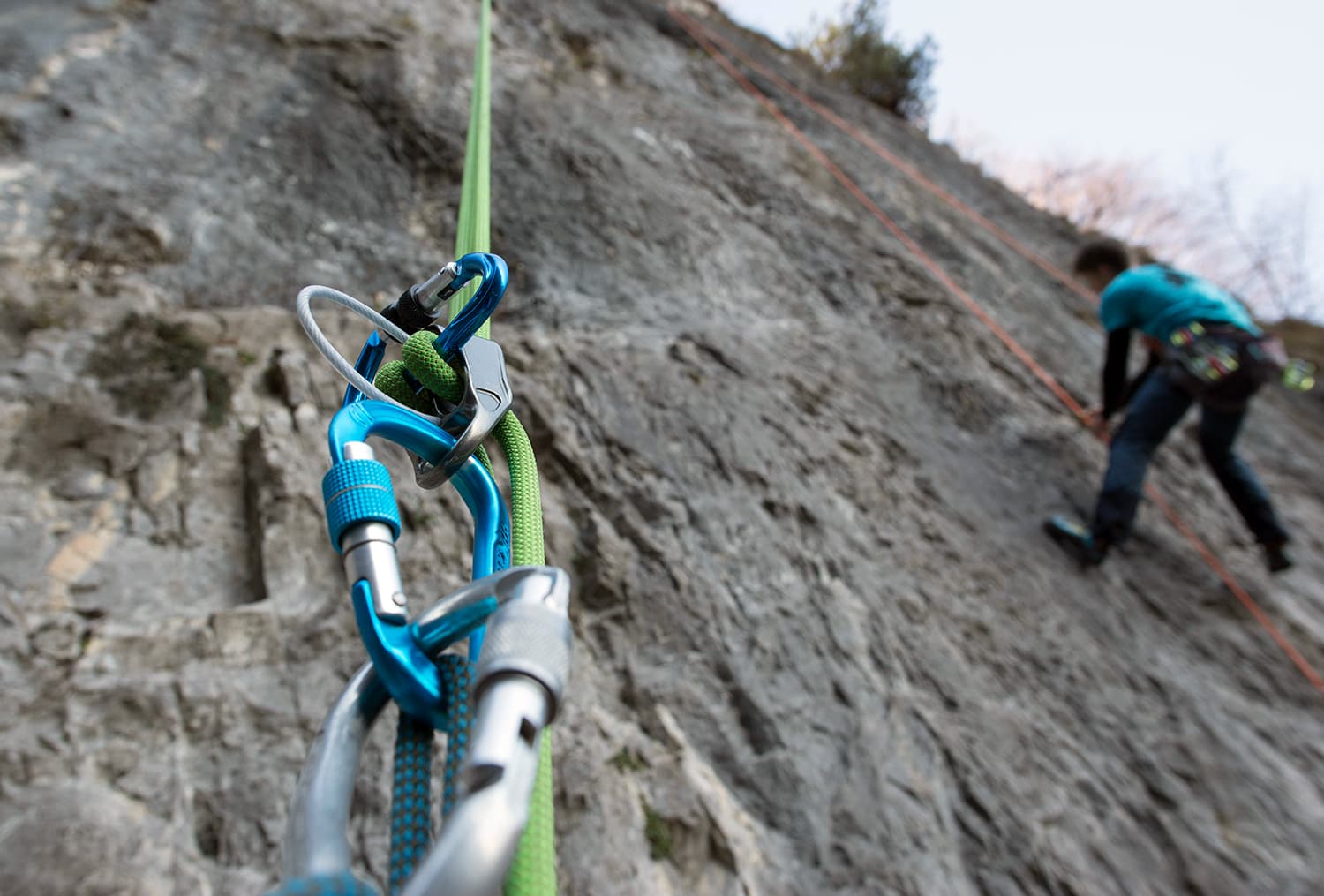
Published on: 06/21/2023
By Teddy Dondanville, AMGA Climbing Guide
There’s no such thing as the ultimate carabiner for climbing. One carabiner can’t rule them all and perform flawlessly in all scenarios.
Instead, having a selection of carabiners on your harness makes much more sense. That way, you can deploy the best climbing carabiner for the specific scenario.
Over my years of climbing recreationally and guiding, I’ve spent a lot of time experimenting with carabiners. I’ve learned a lot; now it’s time to share my knowledge.
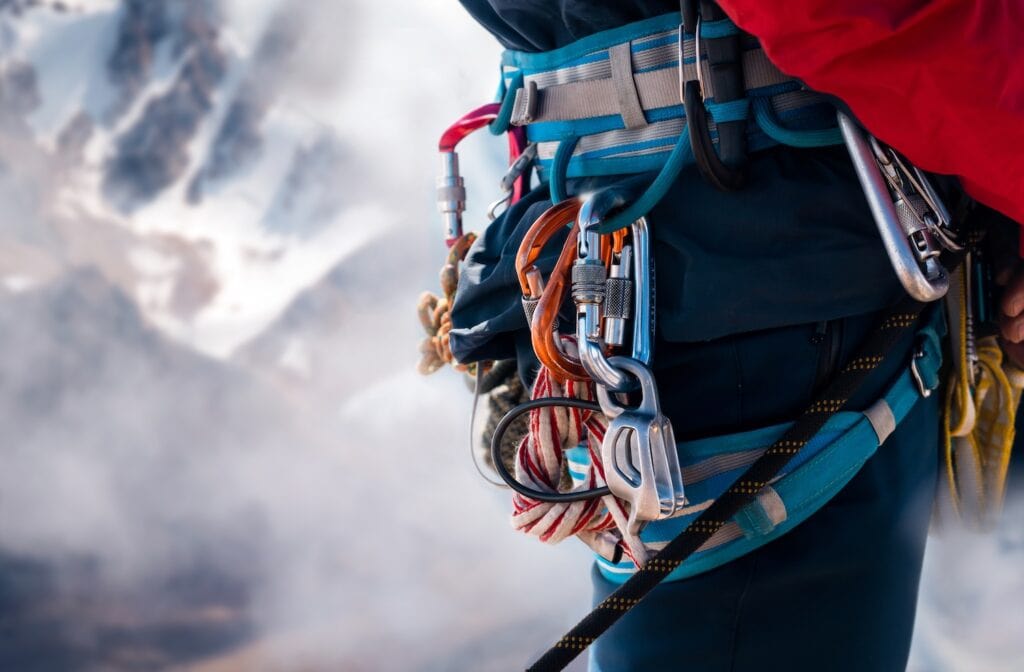
Keep reading to see our selection of the best climbing carabiners in nine categories.
An important side note: purchasing the exact carabiner I recommend may be unnecessary because everyone climbs with different preferences. However, even if you don’t choose the exact one I recommend for each category, I would still strongly recommend to pick a carabiner with similar characteristics.
Our Selection of the 9 Best Climbing Carabiners of 2024

Comparison Table
| Carabiner | Carabiner Type | Gate type | Strength | Size | Best For | Best Offer |
|---|---|---|---|---|---|---|
Petzl Attache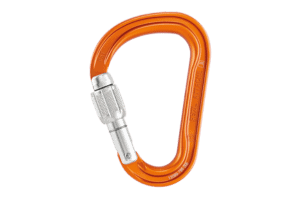 | Locking | Screw lock | 22 kN | Medium | Overall | Check prices |
Petzl Sm’D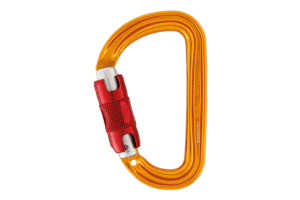 | Locking | Twist lock | 23 kN | Medium | Belaying with a Grigri | Check prices |
DMM Ceros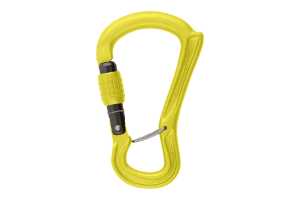 | Locking | Twist lock | 25 kN | Large | Belaying with an ATC | Check prices |
Metolius Steel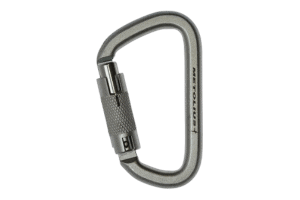 | Locking | Auto-locking gate | 40 kN | Large | Top Rope Anchor Masterpoints | Check prices |
Petzl Djinn Bent Gate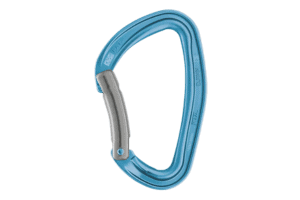 | Non-locking | Bent gate | 23 kN | Medium | Sport Climbing Quickdraws | Check prices |
C.A.M.P. Photon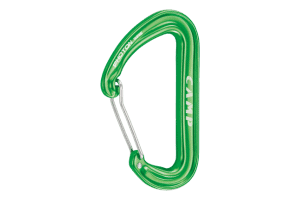 | Non-locking | Wire gate | 22 kN | Small | Alpine Draws | Check prices |
C.A.M.P. Nimbus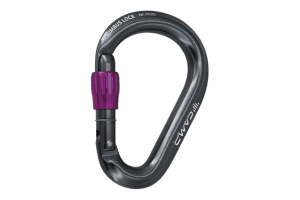 | Locking | Screw lock | 21 kN | Medium | Munter and Clove Hitches | Check prices |
C.A.M.P Nano 22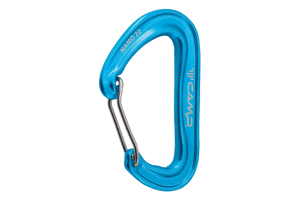 | Non-locking | Wire gate | 21 kN | Small | Racking Gear | Check prices |
Grivel Lambda HMS Twin Gate | Locking | Twin gate | 30 kN | Small | Ice Climbing | Check prices |
1. Petzl Attache: The Best Overall
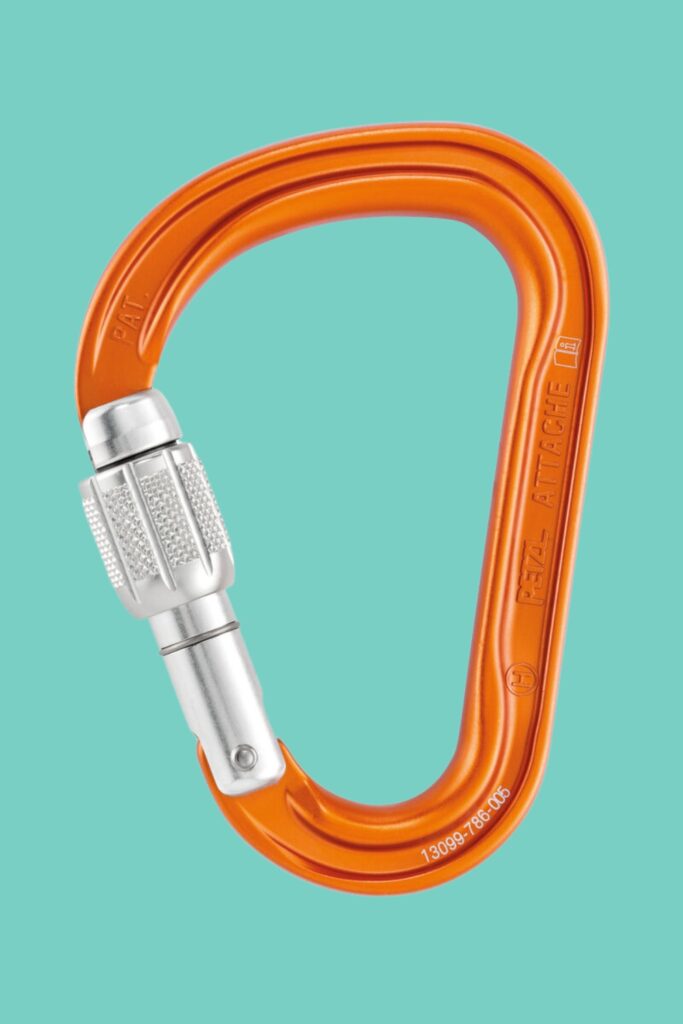
Important Specs
Intended Use: belaying and rappelling, anchoring
Carabiner Type: locking
Gate Type: screw lock
Strength Rating: 22 kN, 7 kN, 6kN
Gate Clearance: 24 millimeters
Weight: 56 g (1.9 oz)
Dimensions: 103 x 69 mm (4.0 x 2.7 in)
Versatility is critical for rock climbing gear. That’s why I prefer to include pieces of equipment in my kit that can perform multiple tasks or in various scenarios.
In terms of carabiners, I found the Petzl Attache to be the best overall and most versatile carabiner. The Attache is a lightweight and compact pear-shaped HMS carabiner. It handles great and has great gate action. You can use it for belaying and rappelling, tying a munter hitch, making anchor points, and tying clove hitches.
Pros
Cons
2. Petzl Sm’D Twist-Lock Carabiner: The Best for Belaying with a Grigri

Important Specs
Intended Use: belaying, tethering
Carabiner Type: locking
Gate Type: twist lock mechanism
Strength Rating: 23 kN, 7 kN, 8 kN
Gate Clearance: 20 millimeters
Weight: 51 g (1.8 oz)
The GriGri is a highly specialized tool. Therefore, it should be paired with a highly specialized carabiner like the Petzl Sm’D Twist-Locking Carabiner.
The Petzl Sm’D Twist-Lock Carabiner is a small asymmetrical D-shaped locking carabiner with a dual-action gate. It’s small size and lightweight design pair nicely with the larger and heavier GriGri. The twist-lock mechanism is easy to use and auto-locks when you close the gate adding extra security (but still double-check your system).
Pros
Cons
3. DMM Ceros Locking Carabiner: The Best for Belaying with an ATC
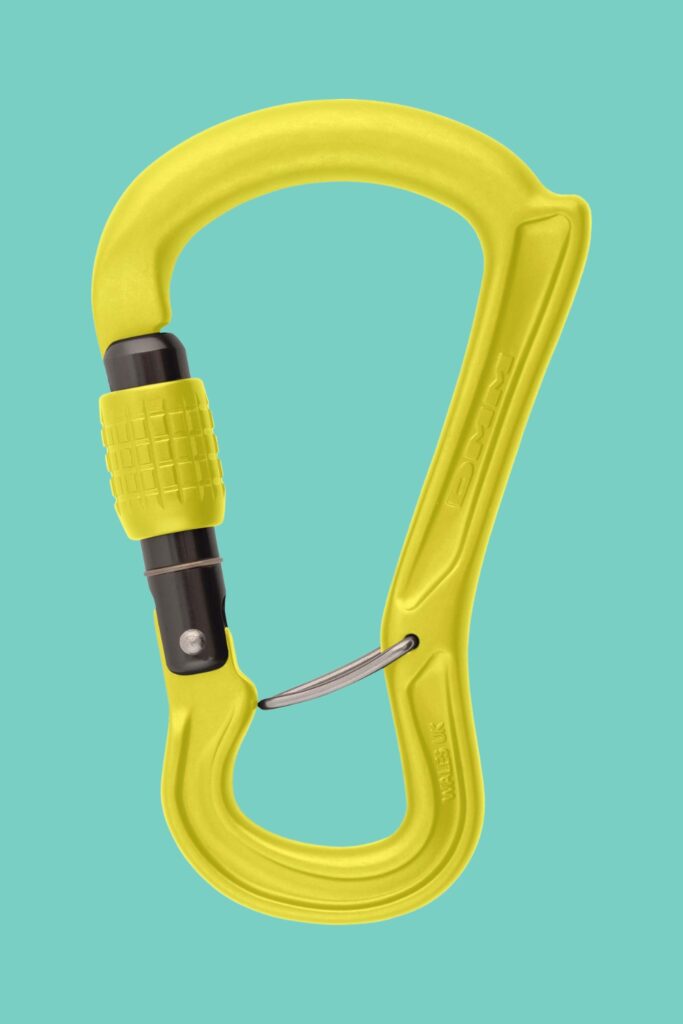
Important Specs
Intended Use: belaying
Carabiner Type: locking
Gate Type: twist lock
Strength Rating: 25 kN, 7 kN, 7 kN
Gate Clearance: 19 millimeters
Weight: 93.56 g (3.3 oz)
Dimensions: 74 x 121 mm (2.9 in x 4.7 in)
Over the years, belay devices have improved. Likewise, so have carabiners designed for belying. Nowadays, you have to select a locker model specifically designed with special features to make belaying more fluid and safer.
The DMM Ceros Locking Carabiner is a perfect example. It’s a specialized locking carabiner for pairing with a belay device, especially ATCs and other similar devices.
It features a belay retainer which helps prevent cross-loading, and a unique horned spine to help keep your belay device in position. And it has a rounded rope-bearing surface ideal for mitigating friction and offering smooth operation.
Pros
Cons
4. Metolius Steel Auto Lock Carabiner: The Best for Top Rope Anchor Masterpoints
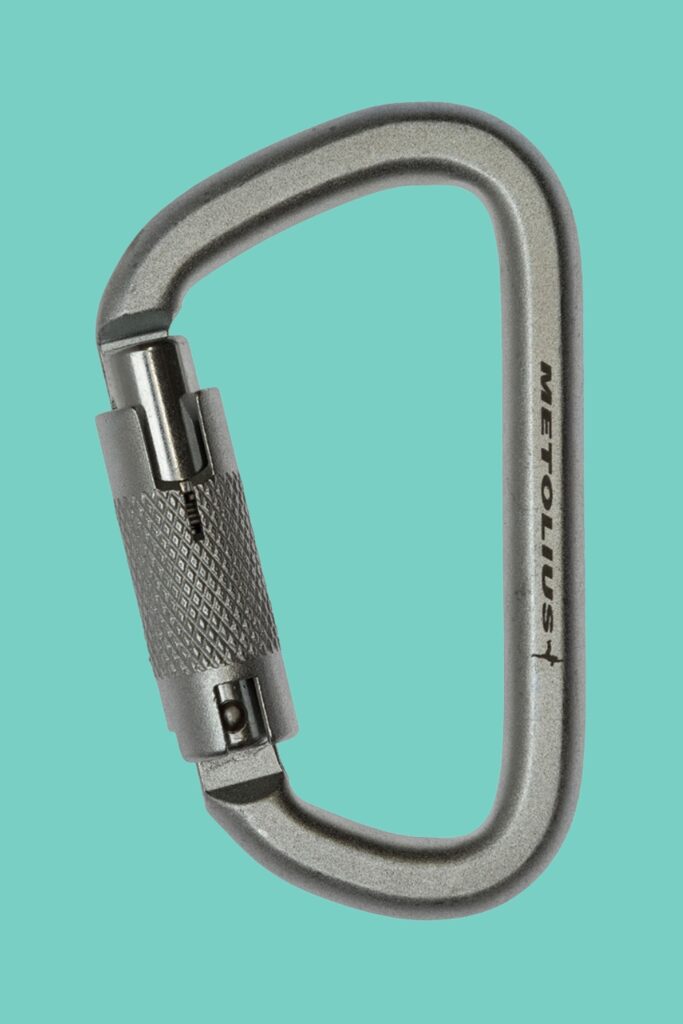
Important Specs
Intended Use: rock climbing, canyoneering, rescue
Carabiner Type: locking
Gate Type: auto-locking gate
Strength Rating: 40 kN, 15 kN, 18 kN
Weight: 221 g (7.8 oz)
Dimensions: 111.1 x 66.3 mm (4.3 x 2.6 in)
In my line of work, top rope anchors receive a beating. So, I like building strong, durable anchors for top ropes.
One of the most important components of a top rope anchor is the master point. I like to use the Metolius Steel Auto Lock Carabiner. Technically speaking, the Metolius Steel Auto Locker is overbuilt for top roping, but I like it because it’s incredibly durable. Plus, I don’t have to worry about the gate opening over the course of the day.
Pros
Cons
5. Petzl Djinn Bent Gate Non-Locking Carabiner: The Best for Sport Climbing Quickdraws
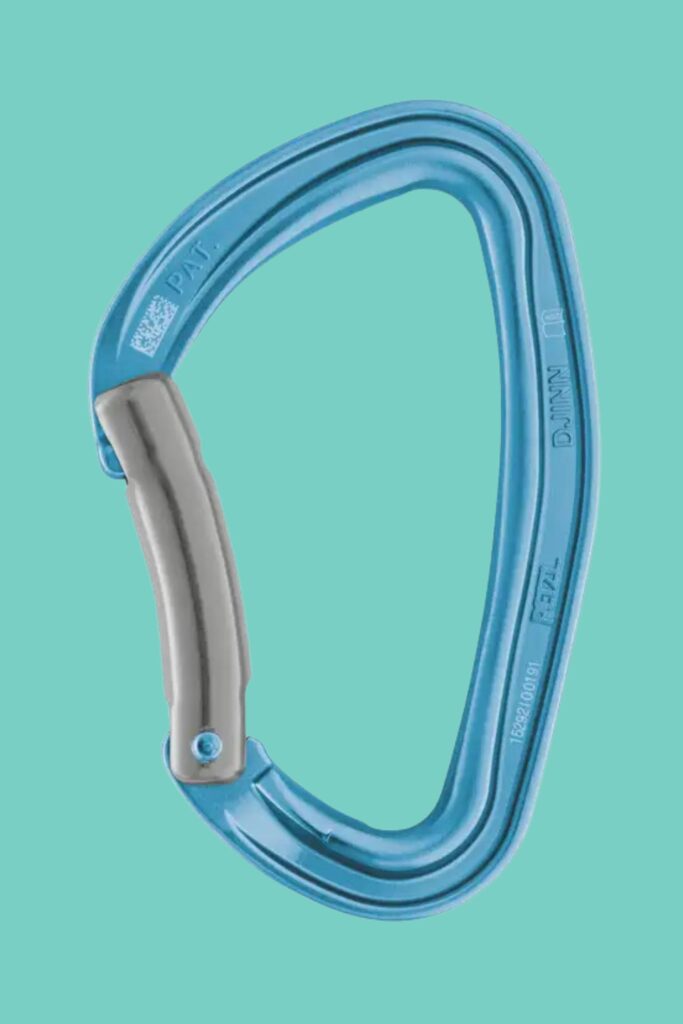
Important Specs
Intended Use: quickdraws, alpine draws, racking gear
Carabiner Type: non-locking
Gate Type: bent gate
Strength Rating: 23 kN, 8 kN, 9 kN
Gate Clearance: 27 millimeters
Weight: 42.5 g (1.5 oz)
When I think of sport-climbing carabiners, two things come to mind– functionality and durability. Sport climbing carabiners should be hyper-functional and easy to use. They should also be durable because sport climbing is rough on carabiners.
The Petzl Djin Bent Gate Non-Locking Carabiner perfectly combines those two characteristics.
The bent gate and large gate clearance are perfect for quickly clipping the rope, and the solid gate design is super durable. Pair the bent gate Djin carabiner with its straight gate counterpart (1) to make the perfect combination of carabiners for your sport climbing quickdraws.
Pros
Cons
6. C.A.M.P. Photon Wiregate Carabiner: The Best for Alpine Draws
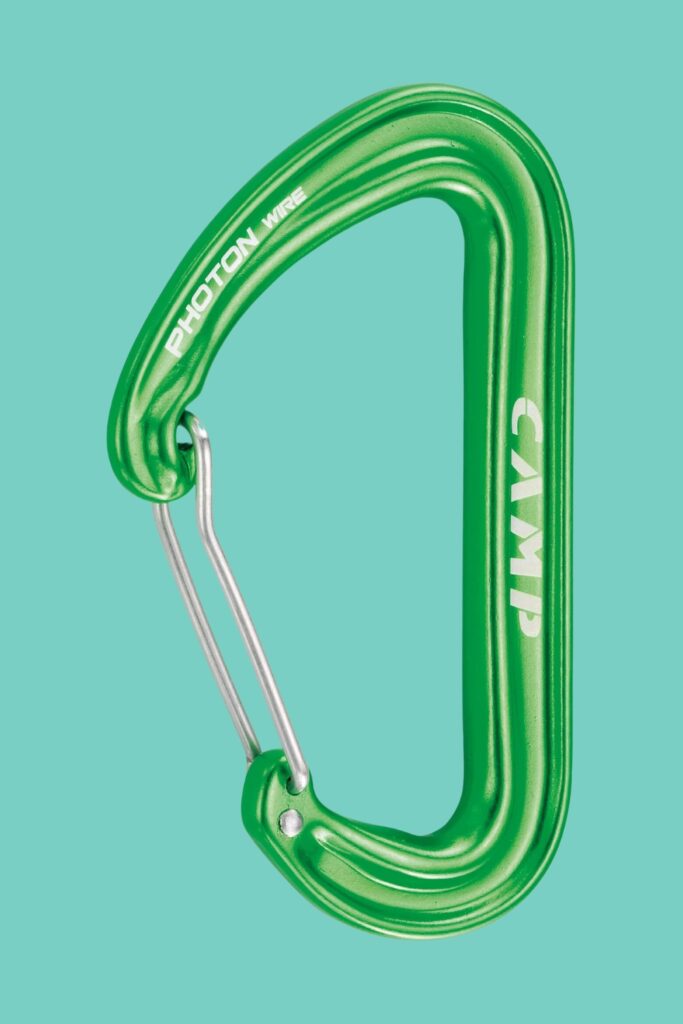
Important Specs
Intended Use: alpine draws, quickdraws, and racking gear
Carabiner Type: non-locking
Gate Type: wiregate
Strength Rating: 22 kN, 9 kN, 8 kN
Gate Clearance: 26 millimeters
Weight: 30 g (1 oz)
Dimensions: 100 x 62 mm (3.9 x 2.4 in)
In the trad and alpine climbing disciplines, alpine draws are super important. For example, they’re critical for extending gear and anchor building. But they can also help you manage rope drag on sport climbs.
Regardless of how you use alpine draws, one thing remains true– the lighter they can be, the better. That’s why the C.A.M.P. Photon Wiregate Carabiner is the perfect carabiner for alpine draws.
Besides being super lightweight, Photons are still full-sized, so they fit nicely in your hand and are super easy to use, even with gloves on in winter climbing scenarios. Their larger gate opening also makes multiple ropes very practical.
Plus, they come in various colors, which helps customize your alpine draws to suit your unique style.
Pros
Cons
7. C.A.M.P. Nimbus Locking Carabiner: The Best for Munter and Clove Hitches

Important Specs
Intended Use: belaying and rappelling
Carabiner Type: locking
Gate Type: screw lock
Strength Rating: 21 kN, 6 kN, 9 kN
Gate Clearance: 22 millimeters
Weight: 69 g (2.4 oz)
Dimensions: 101 x 71 mm (3.9 x 2.8 oz)
In multi-pitch climbing, munters and clove hitches are super useful. Munter hitches can be used for everything from belaying to rappelling and lowering, and the clove hitch is perfect for tethering yourself to the anchor.
That’s why having dedicated locking carabiners on your harness for munters and cloves is essential. The C.A.M.P. Nimbus Locking Carabiner is a perfect example.
The Nimbus is a pear-shaped (HMS) carabiner with a large gate opening and a big basket for munters and cloves. Plus, the lock and gate action is smooth and easily operated with one hand.
Pros
Cons
8. C.A.M.P. Nano 22: The Best for Racking Gear

Important Specs
Intended Use: racking gear, alpine draws
Carabiner Type: non-locking
Gate Type: wire-gate
Strength Rating: 21 kN, 9 kN, 8 kN
Gate Clearance: 21 millimeters
Weight: 22 g (0.7 oz)
Dimensions: 100 x 62 mm (3.9 x 2.4 in)
Trad climbing requires a lot of equipment. That’s why saving weight is super important, especially on big climbs where you are carrying more gear and climbing for longer.
One of the best ways to save weight is with lightweight carabiners – like the C.A.M.P. Nano 22. The Nano 22 is one of the lightest full-strength carabiners on the market. And conveniently, C.A.M.P makes a rack pack (2) of color-coded Nanos to match your different colored cams.
Pros
Cons
9. Grivel Lambda HMS Twin Gate Carabiner: The Best for Ice Climbing Applications
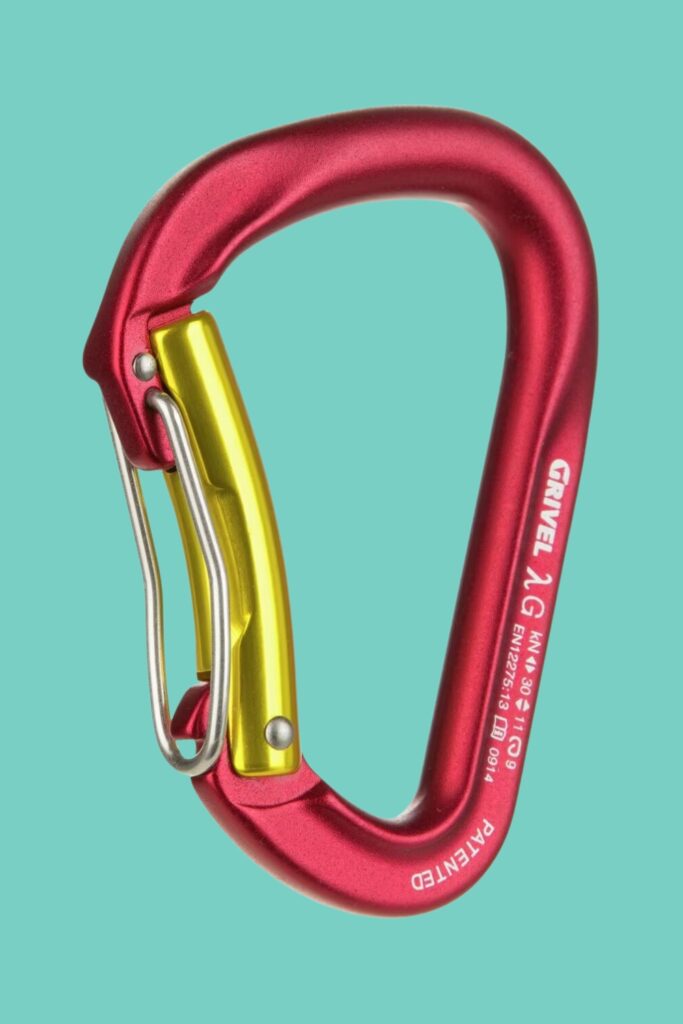
Important Specs
Intended Use: ice climbing, rock climbing
Carabiner Type: locking
Gate Type: twin gate
Strength Rating: 30 kN, 11 kN, 9kN
Gate Clearance: 24 millimeters
Weight: 68 g (2.4 oz)
Dimensions: 98 x 70 mm (3.8 x 2.7 in)
Ice climbing comes with an entirely new set of obstacles compared to rock climbing. That’s why ice-climbing gear is designed specifically for winter conditions, like the Grivel Lambda HMS Twin Gate Carabiner.
The Grivel Lambda is a Twin Gate locking carabiner, meaning it locks without a traditional screw gate. That’s because screw gates are notorious for freezing shut during ice-climbing scenarios. So, instead, the Lambda has two opposite and opposed gates that function together for added security.
The Lambda’s pear shape and large gate clearance make it ideal for munter and clove hitches, the twin gates are buttery smooth, and it’s on the lighter side of HMS pear-shaped carabiners.
Pros
Cons
How to Pick the Most Suitable Climbing Carabiner
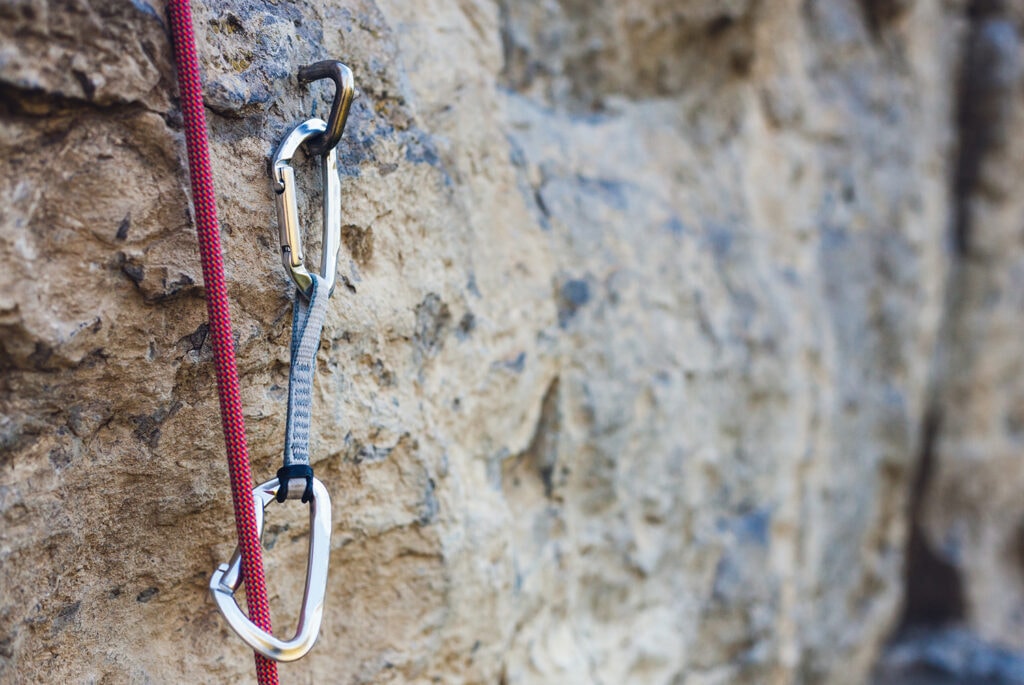
Carabiner manufacturers like to design carabiners for an intended purpose. For example, round stock triple action locking carabiners are great for your belay and rappel device.
Yes, it’s true– some of the best carabiners are versatile and can be used in various scenarios. However, most carabiners excel when you deploy them correctly.
To help you figure out which carabiners are the most suitable for specific scenarios, you need to consider multiple things– the type of carabiner (i.e., locking vs. non-locking), carabiner shape, gate type, strength, size, and weight.
Locking vs. Non-Locking
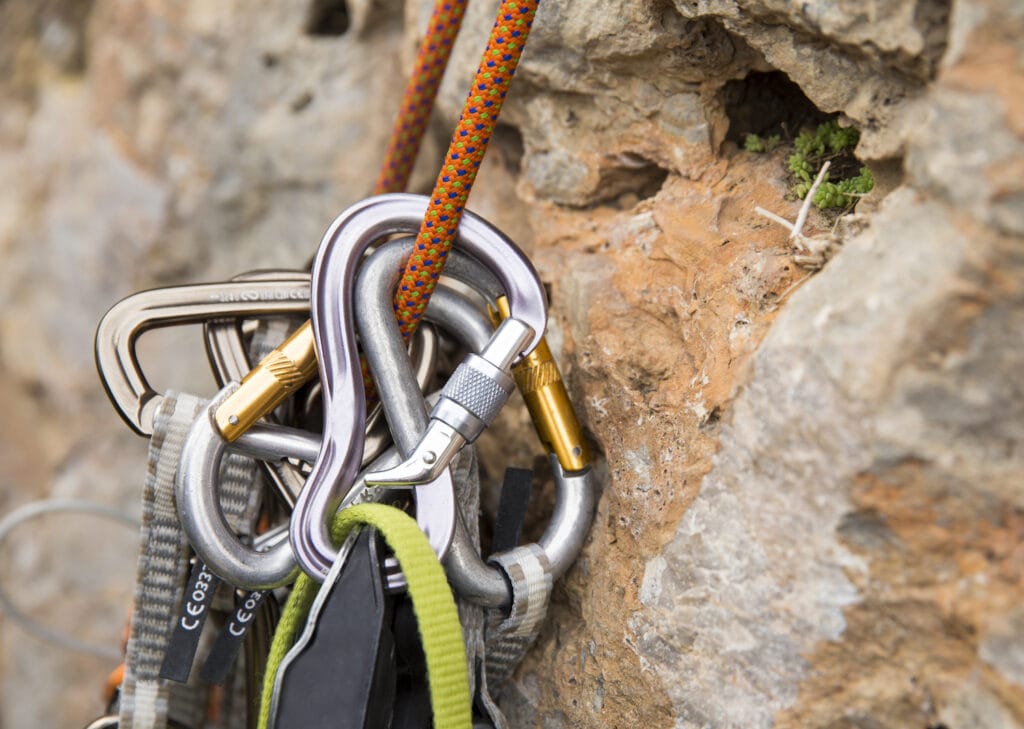
The largest and most important distinction between types of carabiners is whether they are locking or non-locking.
Locking carabiners are used for critical linkages in your climbing system where you want extra security. In this context, critical refers to links where a failure would result in a catastrophic accident. Examples of critical links include attaching your belay device to your harness or the master point in your trad anchor.
On the other hand, non-locking carabiners are utilized for non-critical linkages in your climbing system. Non-critical links are backed up in some way. In other words, a failure of one link would not result in a catastrophic accident, for example, like the quickdraws on a sport route or the carabiners that rack your gear on a gear loop.

Having a selection of locking and non-locking carabiners is essential to prepare for a climb properly. And remember– if you ever run out of lockers, you can use two non-lockers clipped in the opposite and opposed orientation to simulate the security you would get from a locker. This is a common tactic for top ropes in the sport climbing context.
Shape
The carabiner shape is one of the most important characteristics to consider. That’s because certain shapes are better than other shapes, depending on how you want to use the carabiner. For example, using screw lock D-shaped carabiners for your tube-style belay device does not make much sense. Indeed, as the rope is actively running over the carabiner, an HMS carabiner (pear-shape), like the Petzl Attache, will provide a smoother experience.
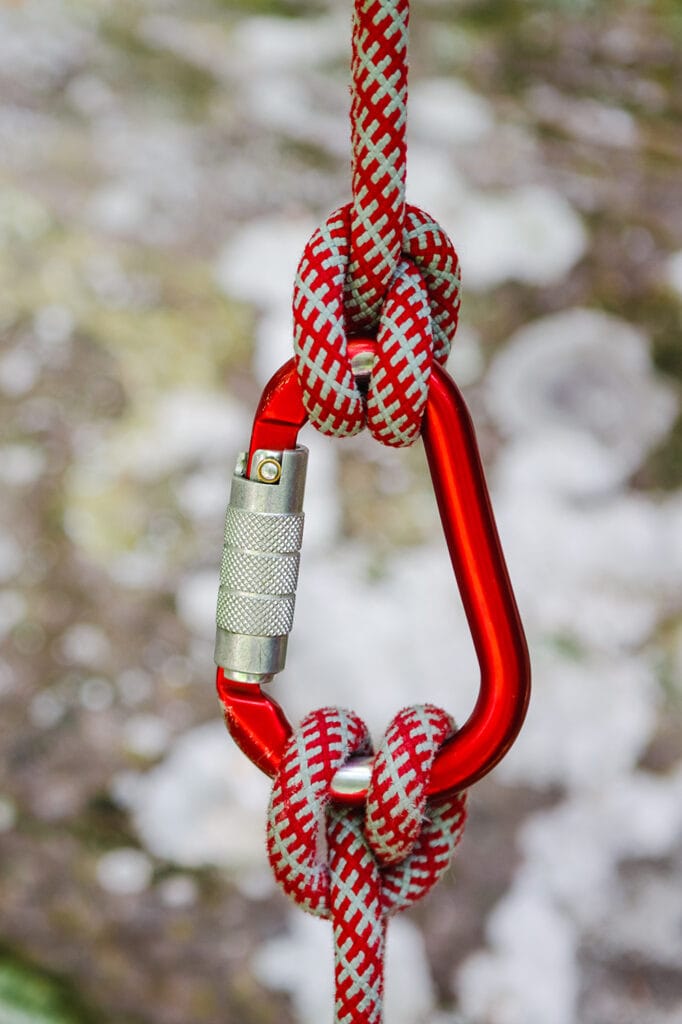
Carabiners come in four primary shapes.
- Oval
- Symmetrical D-shaped
- Asymmetrical or offset D-shaped
- Pear Shaped
Gate Type
The gate of a carabiner dictates how it should be used. For example, straight gates are best for bolts, bent gates are best for ropes, and a large gate clearance makes a clove or munter hitch much easier to tie.
For lockers, it’s all about the locking mechanisms. Gate types for locking carabiners include:
- Screw lock
- Sliding lock
- Wire lock
- Double action
- Triple action
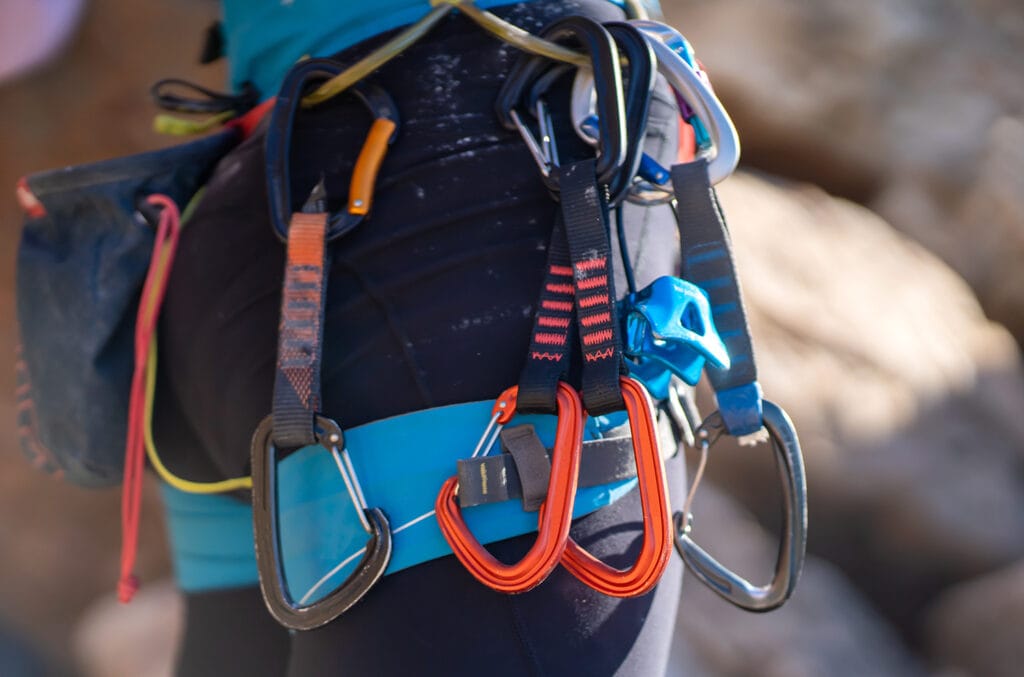
On the other hand, for non-lockers, the big decision is between solid or wire gate construction. The next consideration is whether you want a straight or bent gate. Gate types for non-locking carabiners include:
- Wire gate
- Solid gate
- Bent gate
- Straight gate
Strength, Size and Weight
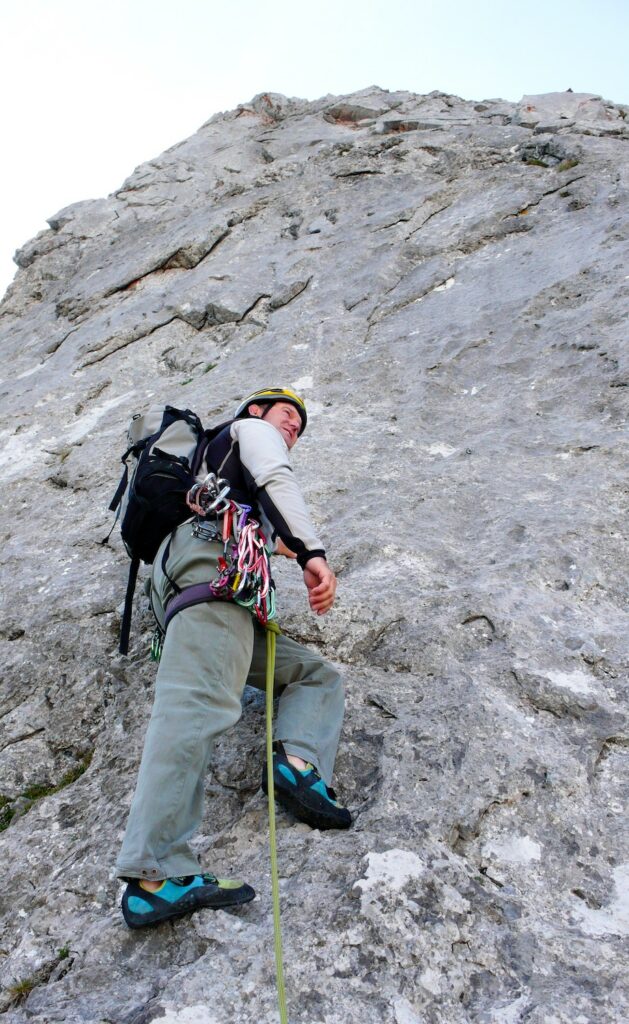
The strength, size, and weight of a carabiner are largely dictated by the materials used in its construction. For the most part, climbing carabiners are made from either steel or aluminum.
Back in the day, almost all the carabiners were steel. However, aluminum carabiners are much more common in modern climbing. Nowadays, there are even carabiners that combine the two materials, like the Edelrid HMS Bulletproof.
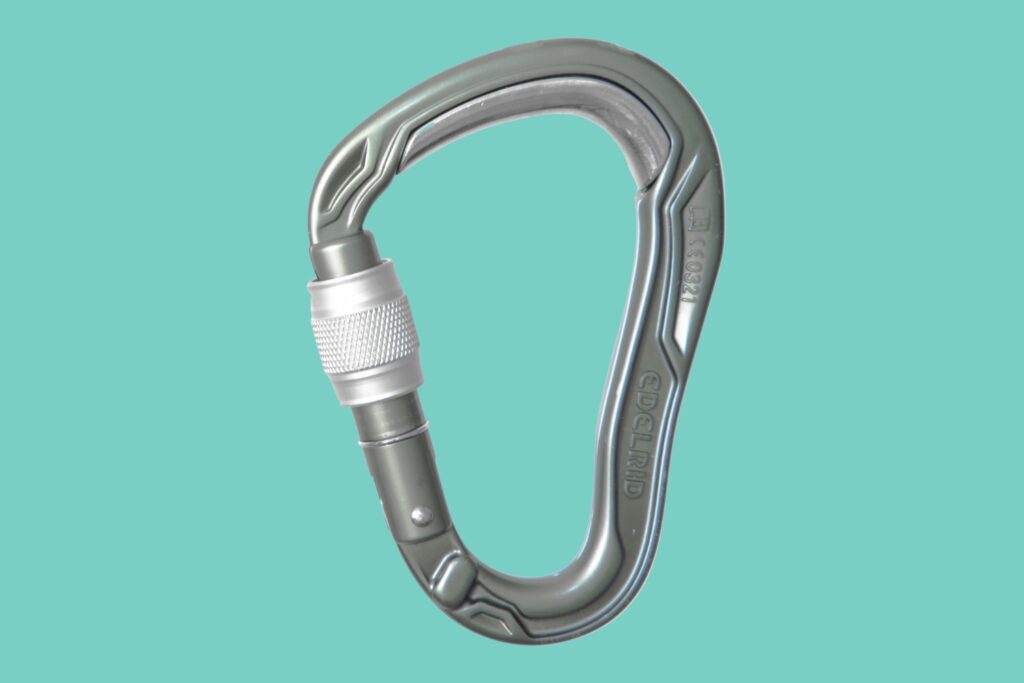
Steel is obviously much stronger than aluminum. However, with extra strength comes extra weight. Therefore, aluminum carabiners have largely replaced 100% steel carabiners. That’s because high-quality aluminum and modern manufacturing processes, like hot forged construction, make exceptionally strong carabiners. Plus, they’re lightweight, which is perfect for multi-pitch routes.
Steel carabiners are also larger than aluminum carabiners. This is okay for some scenarios, like the master point of a top rope. However, the compact size of aluminum lockers is hard to beat, especially when the real estate in bolt hangers is limited. Modern aluminum keylock carabiners also make clipping bolt hangers easier.
Other Items to Consider When Selecting Carabiners
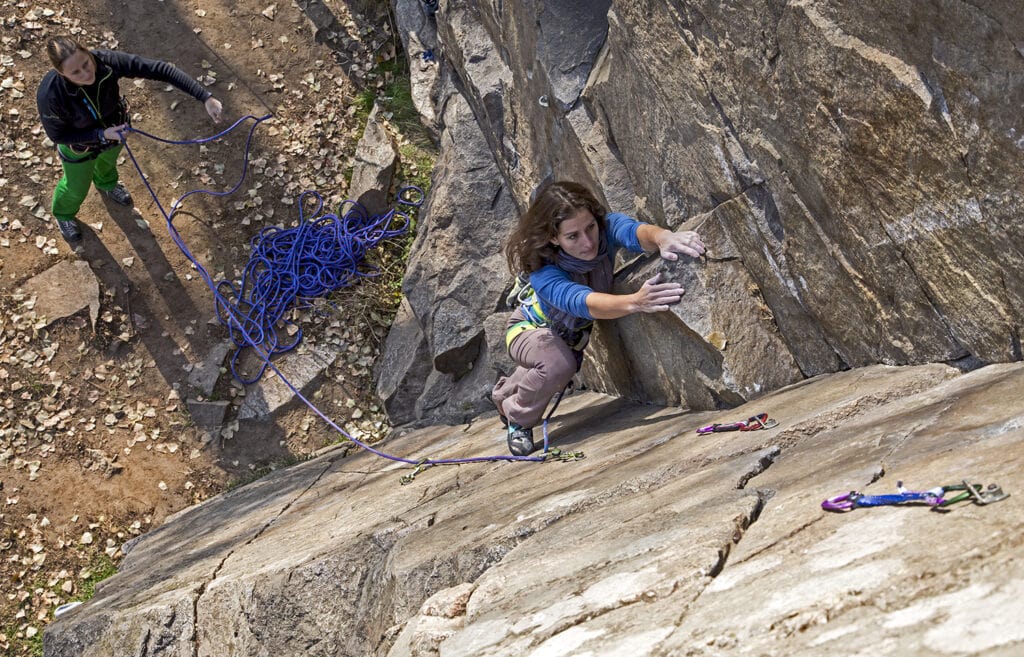
- Climbing Scenarios: for some carabiners, there is a time and place, like auto-locking carabiners on belay devices. Otherwise, I recommend you select carabiners that can function in various climbing scenarios.
- Ease of Use: small, lightweight locking carabiners or mini wire gates are nice, but if you have a hard time operating them, they may not be worth it. So, always consider ease of use with your carabiners, especially if you know you’ll be climbing with gloves.
- Gate Opening: bent gate carabiners have a larger gate opening than straight gates. Similarly, large HMS carabiners have a larger opening than D-shaped carabiners. These things matter when considering the size (and quantity) of rope(s) you are using.
- Gate Security: in my opinion, there is such a thing as too much gate security. In other words, you don’t need triple-action lockers everywhere on your harness. In certain scenarios, they are cumbersome to use, especially with one hand. For some applications, simple screw-lock carabiners offer the ideal amount of security.
- Durability: one fallback of aluminum is that it’s not as durable as steel. This doesn’t mean that aluminum carabiners will wear out overnight– they’ll still last many years. But it’s something to consider.
Tips and Safety Recommendations

Maintain Your Wiregate Carabiners
Over time, wiregate carabiners wear down. In particular, they can get squeaky, and gates refrain from closing. I’ve only ever scene this with the lightest carabiners, like the C.A.M.P. Nano 22. This is a safety concern that requires your attention. Fortunately, there’s a simple solution.
If the wire gate is sticking open from normal wear and tear and debris and not because it’s been damaged, you can clean the rivet pin with warm water. Afterward, if you’d like, you can add a tiny amount of lubricant to the rivet pin to help it maintain functioning.
Monitor for Cross-Loading on Your Belay Carabiner
If you belay with a typical carabiner and not one with preventative cross-loading features, like the DMM Belay Master (3), it’s important to monitor for cross-loading. When cross-loading occurs, your belay device will still function. However, the carabiner will be positioned sideways on the belay loop, either along the locking mechanism or the carabiner’s spine.
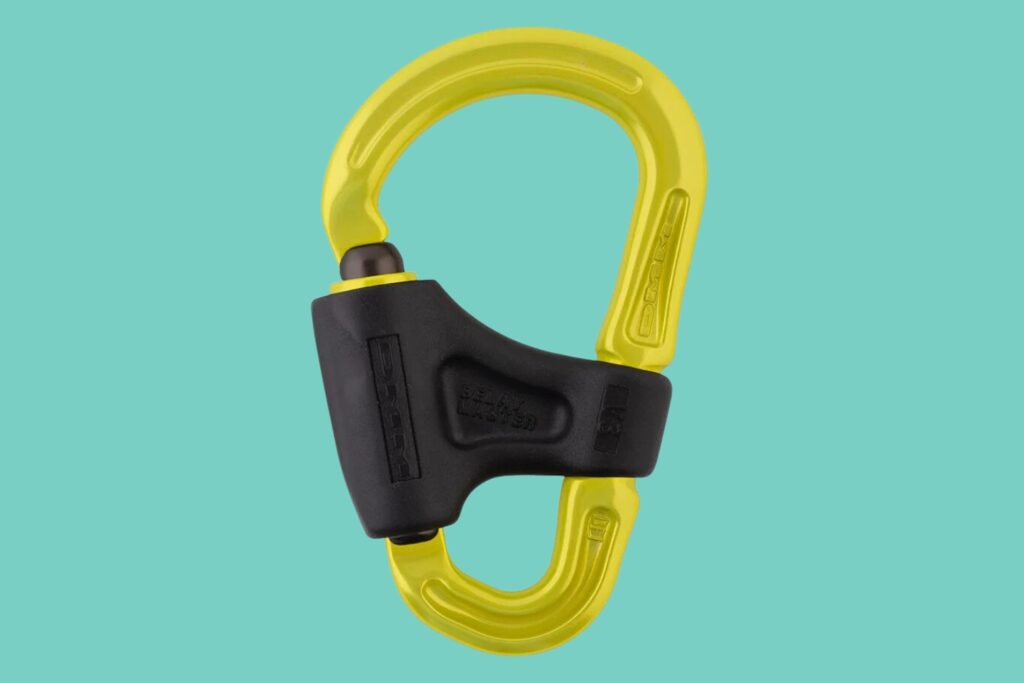
All the carabiners we talked about today, even the “best” carabiner” and heavier carabiners, are drastically weaker when there is a cross-load along the minor axis instead of the major axis.
To prevent this, use belay carabiners like the DMM Belay Master. The Belay Master has an integrated plastic clip that captures the belay loop in the crotch of the carabiner, preventing the Belay Master from rotating and becoming cross-loaded.
Or you can monitor your belay setup and fix the carabiner before a cross-load occurs.
Clip and Flip Your Locking Carabiners
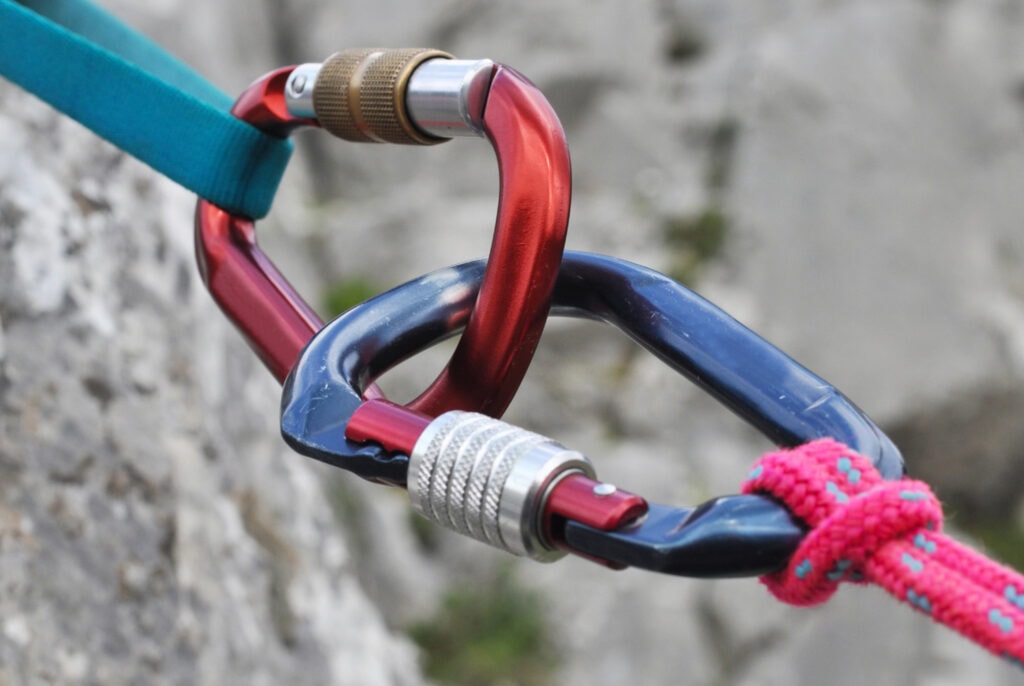
It’s a good habit to start clipping and flipping your locking carabiners, especially screw gates. To clip and flip, clip your locker into where you need it– maybe it’s a belay loop, anchor kit master point, or belay device– and then rotate it so it’s upside down.
Clipping and flipping locking carabiners, especially screw gate carabiners, helps position the basket of the carabiner in a more useful position and will prevent the screw gate opening from opening due to vibrations.
Always Double Check Your Locking Carabiners
It doesn’t matter if you have a carabiner with a triple-action gate. You need to always double-check that your locking carabiners are locked and not left accidentally open. That’s because rigorous testing has shown even carabiners with an auto-locking feature have been known to stay open.
Double-checking locking carabiners, even those that can lock automatically, is a good habit to form and will carry over into scenarios when you using other locking carabiners without a triple-action locking mechanism or auto-lock feature.
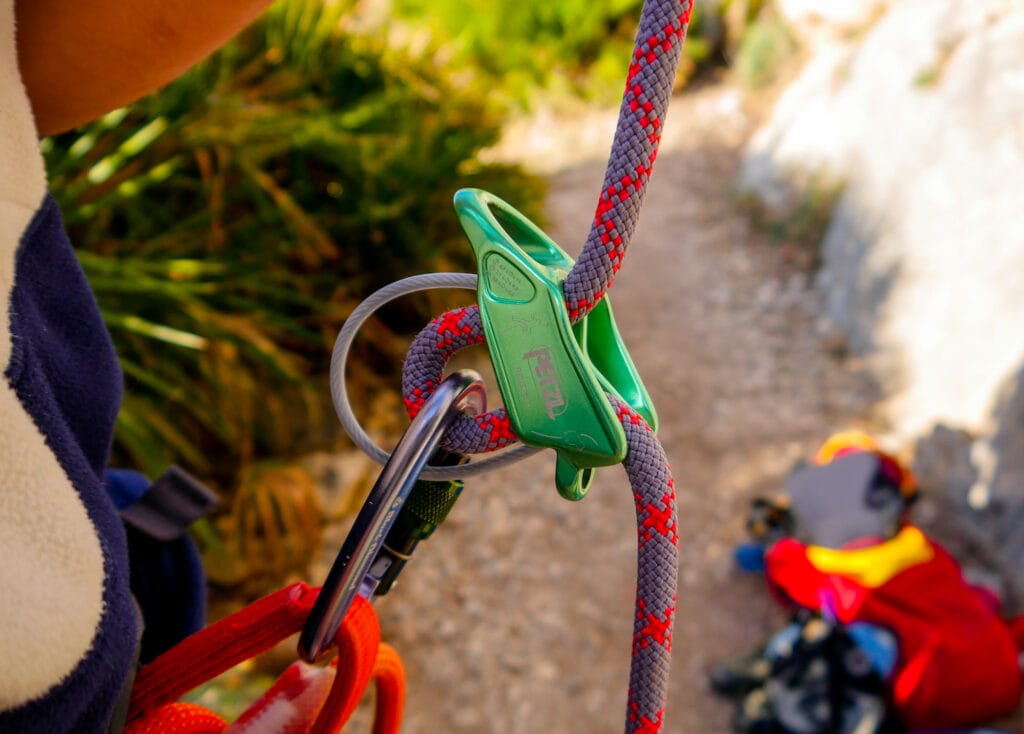
Retire Your Carabiners When Necessary
If you climb long enough, there will come a time when you need to retire your locking carabiners. This is most common with aluminum lightweight carabiners you use to belay and rappel. That’s because with weight savings comes a reduction in durability.
To extend the lifespan of your belay locker, you may consider using one with a stainless steel insert, like the Edelrid HMS Bulletproof (4). The Edelrid HMS Bulletproof has an additional stainless steel insert covering the basket of the carabiner to mitigate wear and tear on the carabiner itself and the rope.
Final Thoughts
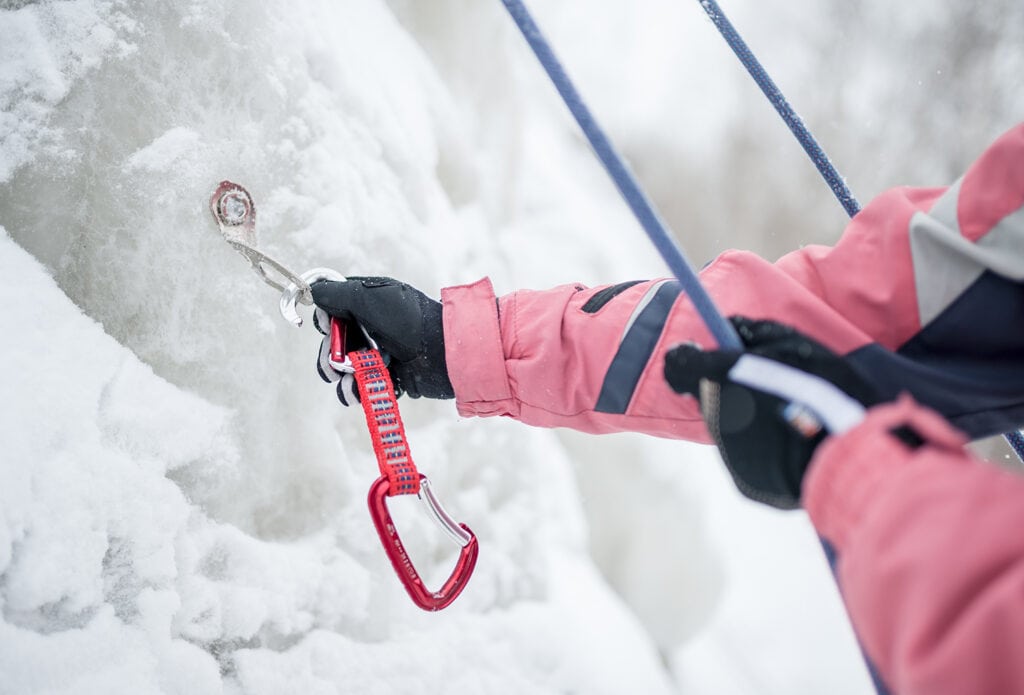
The best climbing carabiner is the one designed specifically for your intended use. When it’s time to equip yourself with new carabiners, don’t just go for the most affordable carabiners. And don’t get trapped buying the smallest carabiners because they are lightweight.
Instead, consider the action or task you need a carabiner for, and buy the carabiner designed to help you accomplish that.
Good luck with your carabiner journey. May you never fall on a cross-loaded carabiner, may your gates never freeze shut, and may the rope always keep you safe. And as always, remember to do your double-checks.
References
Petzl Djinn Straight Gate Carabiner (retrieved on 06/20/2023)
https://www.rei.com/product/151962/petzl-djinn-straight-gate-carabiner
C.A.M.P. Nano 22 Rack Pack (retrieved on 06/20/2023)
https://www.rei.com/product/110187/camp-nano-22-rack-pack
DMM Belay Master (retrieved on 06/20/2023)
https://dmmwales.com/climbing-products/locking-carabiners/belay-master
Edelrid HMS Bulletproof Screw Carabiner (retrieved on 06/20/2023)
https://www.rei.com/product/150383/edelrid-hms-bulletproof-screw-carabiner
